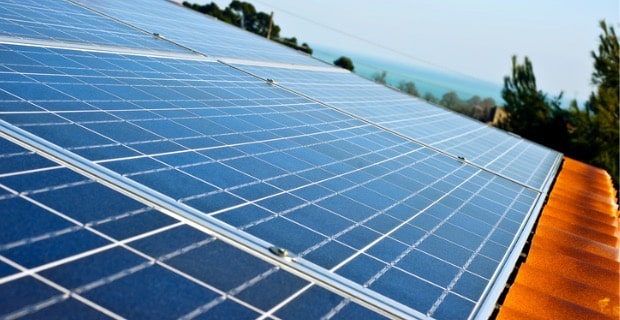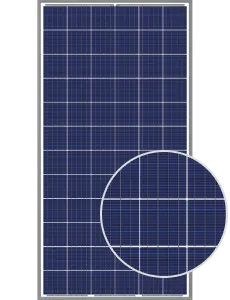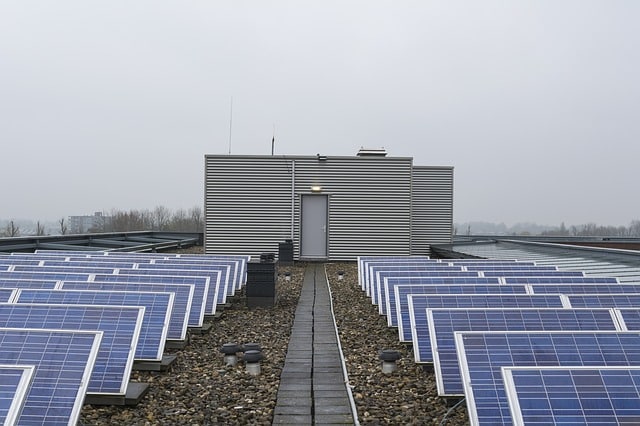
Solar panels absorb light from the sun, producing renewable energy in the form of solar electricity. A solar panel comprises numerous layers, the one containing the matrix of sun cells being the most significant. There are different types of solar panel options, and one of them is Polycrystalline solar panels.
On This Page
Manufacturers fuse many silicon shards to create wafers or cells for the screen rather than employing a single silicon crystal, as suggested by the polycrystalline solar panel’s name. The minimal wastage makes polycrystalline cells more economical and gives them their distinctive square shape. Multi-crystalline or many-crystal silicon is another name for polycrystalline solar cells.
Polycrystalline solar panels are less efficient than monocrystalline cell alternatives because each cell has many more crystals, which limits the electrons’ freedom to flow. These panels generally cost less since the manufacturing process is simpler. In addition, polycrystalline solar panels typically have a blue hue rather than monocrystalline solar panels’ black hue. Check out our page to learn tips and choose the best solar panel.
How are polycrystalline solar panels made?

Single polycrystalline solar cells are used to create polycrystalline solar panels. Similar to monocrystalline cells, polycrystalline solar cells are made of crystalline silicon. Silicon crystals break up into tiny pieces instead of extruding into pure ingots. After heating, they are rolled into a cube and thinly sliced. The amalgam is made of numerous crystallisations. This slower and less expensive manufacturing method produces more solar cells more quickly and affordably.
The advantages of polycrystalline solar panels
The following are some advantages of polycrystalline panels.
- Less expensive than monocrystalline panels – Due to their ease of manufacture and use of numerous silicon cells, polycrystalline solar panels are less costly than monocrystalline ones.
- On the polycrystalline panel, there is less waste because of how the silicon wafers are put into the panel.
- There are few fossil fuels needed for the manufacturing process.
The disadvantages of polycrystalline solar panels
Here are some disadvantages of polycrystalline solar panels.
- Panels require more space.
- Less efficient at producing energy – Due to the lower silicon purity, polycrystalline solar panels have a lower efficiency than monocrystalline solar panels.
- Less sustainable production.
- The bluish colour stands out more than the black of the polycrystalline panels.
- Less heat tolerance – When exposed to extreme temperatures, they deteriorate quickly.
Best applications for polycrystalline solar panels

- Larger areas with maximum sunlight – They are used in large solar farms to harness the sun’s power and provide electricity to adjacent areas.
- Cost is the most important.
- Aesthetics is not a priority.
- Roofing-mounted arrays are a good fit for polycrystalline panels.
- They are utilised in independent or self-powered equipment like off-grid homes, remote traffic signals, etc.
Polycrystalline vs poly PERC solar panels
Unfortunately, a few difficulties affect the efficiency of traditional silicon solar cells. Some losses result from inefficiencies in the process of capturing sunlight. The solar cell may reflect light, wires may obstruct it, or light may pass through the cell and into the rear.
What is a PERC solar panel, and how do they differ from Polycrystalline?
The standard in the solar industry has long been conventional silicon photovoltaic (PV) cells. Researchers and manufacturers have begun to embrace a relative newcomer, the Passivated Emitter and Rear Contact (PERC) solar cell, though, as the technology develops and gets closer to strict efficiency constraints.
PERC technology is not new, having been invented in 1983 by Australian scientist Martin Green and his team at the University of New South Wales. Yet PERC solar cell technology-based commercially accessible PV modules are still very new since materials scientists had to work out several issues before commercialising the technology.
Two additional stages are added to the regular back surface field (BSF) during the manufacturing process to produce a PERC cell. A rear surface passivation film is first put on. Second, the rear passivation stack is opened using lasers or chemicals, and tiny pockets are made in the film to absorb light. Manufacturers can take different approaches (e.g., by changing the recipe or opening method). Still, a dielectric passivation layer is placed on the cell’s back.
Poly PERC solar panels are simply an improvement of traditional polycrystalline solar panels.
Benefits of Poly PERC solar panels
Solar PV installation can save time and money when employing the more recent PERC standard because fewer panels are required to produce the same amount of solar power. The quantity of racking, wiring, and other necessary components to tie things together can be decreased using fewer panels.
Poly PERC panels are still slightly more expensive than traditional polycrystalline solar panels. Still, these costs are significantly offset by the enhanced efficiency improvements, which result in higher lifetime power bill savings and carbon offsets for the end user. Poly PERC cells will probably continue to gain from even more significant efficiency gains and cost reductions as the technology develops further due to economies of scale.
Energy Matters has a nationwide network of trusted local installers ready to provide you with up to 3 Free Solar Quotes. Complete our quick quiz and begin your solar journey today!









































